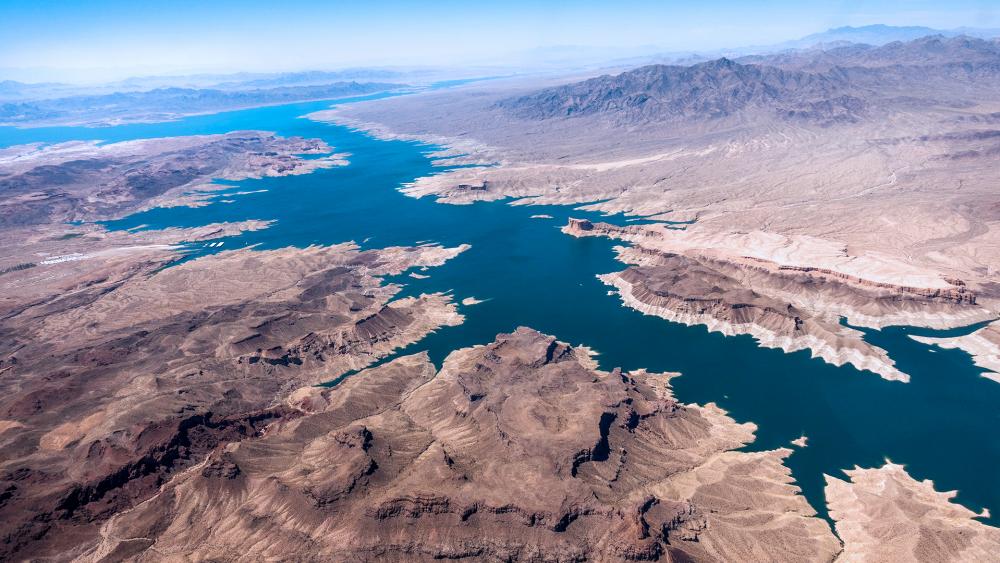Energy and agriculture in the drought-stricken western U.S. are suffering as the water supply in some major reservoirs is dwindling. Geologists say we haven't seen conditions like this in more than 1,000 years.
Lake Mead, which is fed by the Colorado River, provides water for 22 million people in seven states including Arizona, California, Colorado, Nevada, New Mexico, Utah, and Wyoming. Lake Powell, which stretches from Arizona to Utah, is also a big part of the water equation in the region.
Now, both Lake Powell and Lake Mead reservoirs are half-empty, and scientists predict that they will probably never fill again, according to the Glen Canyon Institute, a non-profit organization dedicated to changing Colorado River management to fill Lake Mead first and then use Lake Powell as a backup during flood years.
Over the past two decades, the water level in Lake Mead has dropped by 130 feet. It's now down to 37 percent capacity. On June 9th, the water level dipped to 1,071.57 feet above sea level, narrowly beating a record low last set five years ago.
***Please sign up for CBN Newsletters and download the CBN News app to ensure you keep receiving the latest news from a distinctly Christian perspective.***
The U.S. Bureau of Reclamation says the lake level will probably keep falling until November, meaning the continued drop in water level could impact the entire western U.S.
More than half of the western United States is now in the highest category of drought.
The water shortage is affecting farmers who can't plant crops, as well as hydroelectric power from the Hoover Dam, forcing a nearly 25 percent cut in output.
"So next year, we are gonna get 25% less water. Means we're going to have to fallow — or not plant — 25% of our land," Arizona farmer Dan Thelander told 8NewsNow.com.
Many farmers across the region are rushing to dig wells to supply water for their crops. In Arizona, farmers in Pinal County south of Phoenix have had to stop irrigating their fields because of the shortages.
The other western states that rely on the Colorado River for water are also preparing for the federal government to issue its first-ever official water shortage declaration.
If the government declares a water shortage for 2022, it would mean a decline of about 8,000 acre-feet of water just for Nevada, according to 8NewsNow.com. That's an estimated 2,606,808,000 gallons of water. An acre-foot of water is the amount needed to cover one acre in one foot of water. (325,851 gallons)

(The Colorado River runs through the Glen Canyon National Recreation Area. Image credit: Leslie Cross/Unsplash)
Nevada is trying to be proactive when it comes to conserving water. On June 4th, Gov. Steve Sisolak signed legislation to make the state the first in the U.S. to ban certain kinds of grass.
The measure will ban water users in southern Nevada from planting decorative grass so they conserve water. The grass ban starting in 2027 applies to office parks, entrances to housing developments, and street medians. But it does not apply to single-family homes or parks.
Water officials say the ban will eliminate about 31% of the grass in the region.
Sisolak said last week that anyone flying into Las Vegas viewing the "bathtub rings" that delineate how high Lake Mead's water levels used to be can see that conservation is needed.
"It's incumbent upon us for the next generation to be more conscious of conservation and our natural resources — water being particularly important," he said.
The water shortage could make Las Vegas the first Nevada city to suffer the most. The city is already preparing for the worst drought in two decades. But experts fear that won't be near enough. Lake Meade provides about 90 percent of Las Vegas's water. With the population increasing by 50 percent since 2002, it's draining more and more water out of the system and officials may soon have to reduce the water flow, potentially causing people to pack up and leave.

(In this photo provided by Rusty Bowers, Arizona House Speaker Rusty Bowers walks through the remains of his family's weekend home on Tuesday, June 8, 2021, that was destroyed by a wildfire the day before. Image credit: Elijah Cardon/Rusty Bowers via AP)
Meanwhile, wildfires are scorching the drought-stricken Southwest, signaling what could be a devastating summer.
The National Interagency Fire Center on Thursday reported that so far this year, 23 large fires have burned across nearly 400 square miles (1,036 square kilometers) of wildlands in nine states. New large fires were reported last week in California, Colorado, Michigan, and Utah.
The largest fires currently burning are in Arizona, New Mexico, and Nevada, states hit exceptionally hard by the drought.
The drought, coupled with rising temperatures, has led to widespread fire restrictions in Utah, New Mexico, and Arizona, including fireworks ahead of the July 4 holiday.
Did you know?
God is everywhere—even in the news. That’s why we view every news story through the lens of faith. We are committed to delivering quality independent Christian journalism you can trust. But it takes a lot of hard work, time, and money to do what we do. Help us continue to be a voice for truth in the media by supporting CBN News for as little as $1.












 Support CBN News
Support CBN News







